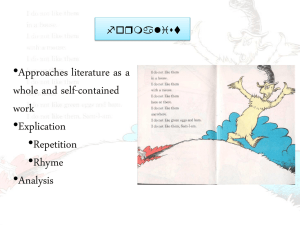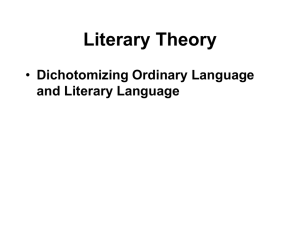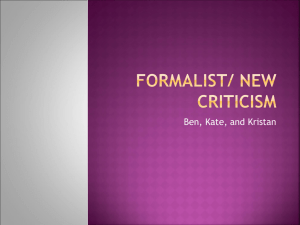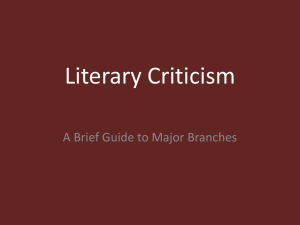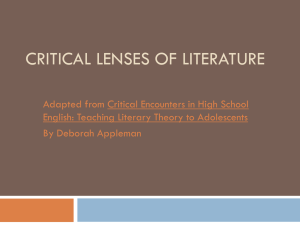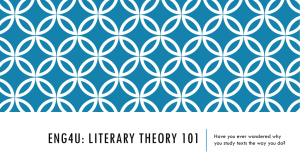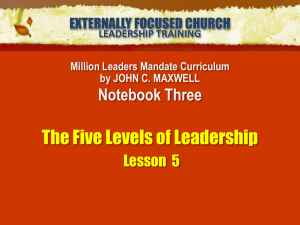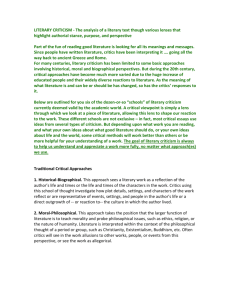Word - Saint Mary`s Press
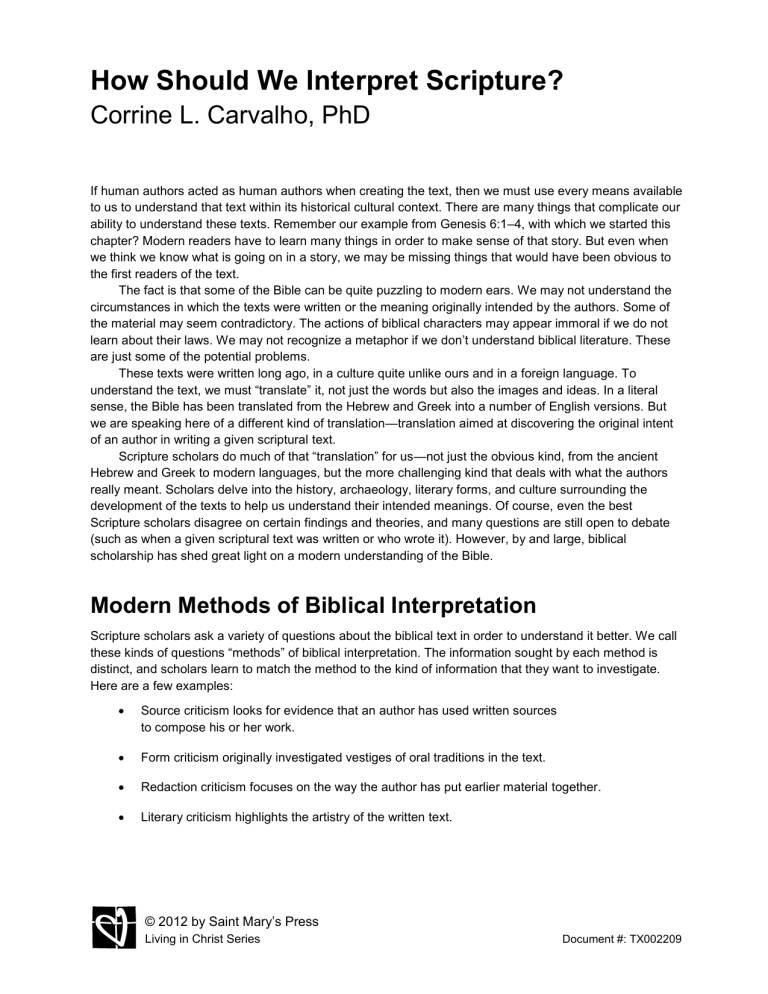
How Should We Interpret Scripture?
Corrine L. Carvalho, PhD
If human authors acted as human authors when creating the text, then we must use every means available to us to understand that text within its historical cultural context. There are many things that complicate our ability to understand these texts. Remember our example from Genesis 6:1 –4, with which we started this chapter? Modern readers have to learn many things in order to make sense of that story. But even when we think we know what is going on in a story, we may be missing things that would have been obvious to the first readers of the text.
The fact is that some of the Bible can be quite puzzling to modern ears. We may not understand the circumstances in which the texts were written or the meaning originally intended by the authors. Some of the material may seem contradictory. The actions of biblical characters may appear immoral if we do not learn about their laws. We may not recognize a metaphor if we don’t understand biblical literature. These are just some of the potential problems.
These texts were written long ago, in a culture quite unlike ours and in a foreign language. To understand the text, we must “translate” it, not just the words but also the images and ideas. In a literal sense, the Bible has been translated from the Hebrew and Greek into a number of English versions. But we are speaking here of a different kind of translation —translation aimed at discovering the original intent of an author in writing a given scriptural text.
Scripture scholars do much of that “translation” for us—not just the obvious kind, from the ancient
Hebrew and Greek to modern languages, but the more challenging kind that deals with what the authors really meant. Scholars delve into the history, archaeology, literary forms, and culture surrounding the development of the texts to help us understand their intended meanings. Of course, even the best
Scripture scholars disagree on certain findings and theories, and many questions are still open to debate
(such as when a given scriptural text was written or who wrote it). However, by and large, biblical scholarship has shed great light on a modern understanding of the Bible.
Modern Methods of Biblical Interpretation
Scripture scholars ask a variety of questions about the biblical text in order to understand it better. We call these kinds of questions “methods” of biblical interpretation. The information sought by each method is distinct, and scholars learn to match the method to the kind of information that they want to investigate.
Here are a few examples:
Source criticism looks for evidence that an author has used written sources to compose his or her work.
Form criticism originally investigated vestiges of oral traditions in the text.
Redaction criticism focuses on the way the author has put earlier material together.
Literary criticism highlights the artistry of the written text.
© 2012 by Saint Mary’s Press
Living in Christ Series Document #: TX002209
How Should We Interpret Scripture? Page | 2
Contextual criticism recognizes the importance of the reader’s cultural context in interpretations of the Bible.
Source Criticism
If you read Genesis 12 –22, you may begin to notice that rather than a continuous narrative, the Abraham cycle is episodic and disjointed. Some anomalies are rather glaring, such as these:
There are three stories in which one of the patriarchs claims that his wife is his sister, placing her sexual purity at risk.
In the story of the banishment of Hagar and Ishmael (Gen 21:15 –16), the boy appears to be an infant or a toddler. However, according to the chronology of the text, he is well over fourteen years old.
In Genesis 6:3 God limits human life to 120 years, but Abraham lives to 175 (Gen 25:17) and
Sarah to 127 (Gen 23:1).
Source criticism is a method that provides a model for imagining the writing process that led to the
Pentateuch and other biblical books as we now have them. Using source criticism, many theories and models have been developed for understanding the anomalies and discrepancies within Genesis.
One of the better scholarly theories imagines the author of the Pentateuch relying on multiple sources when compiling the books. Archaeological discoveries have provided evidence that it was common practice for authors to freely use and adapt earlier material. It was a way of showing respect for earlier scribes.
By the end of the nineteenth century, the four-source theory was well established. Julius Wellhausen published the most influential version of this model, using sociological theories of religious development in addition to literary cues.
Form Criticism
One of the most prominent methods used in biblical interpretation is “form criticism,” a method that helps scholars think about how biblical material was spoken and heard by the ancient Israelites. It is a very complex method, but I want to highlight some of its main points.
A “form, or a “formula” is a phrase that tells an audience how to read or hear what follows. Let me quote an example y ou all know: “Once upon a time . . .” As soon as you hear these words, you know that what follows is a fairy tale. It would be silly to use this phrase in a newscast or a history textbook.
A form can also tell the audience something about the social location of the speaker. Today, a minister starts a speech with the words, “Dearly beloved, we are gathered here today . . .” In ancient Israel, prophets said, “Thus says the L
ORD
. . .” Others can use these forms, but when they do, they either take on another role or use the forms derivatively. This social aim of form criticism is called the Sitz im Leben or
“setting in life.”
Every society is filled with “forms,” although not all forms are words. Have you ever channel-surfed?
You can do so because you know the visual and verbal “forms” of various television programs. The screen for a homeshopping network looks quite different from that of a crime drama. Even with a genre, such as music videos, distinct forms differentiate the country music channel from the rock-video station.
© 2012 by Saint Mary’s Press
Living in Christ Series Document #: TX002209
How Should We Interpret Scripture? Page | 3
When we study the Bible, we can only recover the verbal forms. We can’t “see” if a prophet looked different than a priest, or if the delivery of a prophetic oracle had a different visual setting than the reading of the law. We can, however, detect patterns in the words. These patterns are “forms.”
The patterns tell us what kind of material we have. You have already learned some biblical forms, such as laws and psalms. In future chapters we will examine the forms of proverbs and the short story.
These forms give us a small clue into how these varying materials were spoken and heard.
Redaction Criticism
Source criticism seeks evidence of different written sources that were used in composing a text. It goes
“behind” the text to investigate the history of its production. It arose as a way to explain such things as changes in style, vocabulary, and characterization, as well as repetitions and contradictions.
Like the author of the book of Genesis, the author of Exodus used sources in creating the text, including J, E, and P. Evidence of the sources can be found, for example, in the different explanations for the crossing of the sea in chapters 14 and 15. It is not surprising that each source has an account of the exodus, since this event was central to Israelite religion, just as all four gospels contain an account of the death of Jesus.
Source criticism aims to identify each separate strand of the text. Redaction criticism examines how and why these strands were put together. Source and redaction criticisms often go hand-in-hand; together they are tools for examining the history of the text’s production.
Redaction criticism is most compelling when we have at least some of the sources that the redactor used. This is the case for the first three gospels in the New Testament (Matthew, Mark, and Luke), which exhibit interdependence; likewise, it is true for 1 and 2 Chronicles, which are dependent on several other biblical books. In these cases, a biblical scholar can see the additions, deletions, or rearrangements of material done by the redactor. These changes can reveal the particular interests or emphasis of an author.
These examples serve as a model when the earlier sources no longer exist. Such is the case for the
Pentateuch.
Clearly the redactor used different traditions. Source criticism isolates these sources; redaction criticism asks why they have been put together in this particular way.
In this sense, redaction criticism highlights the literary artistry of the final author. Let me use a contemporary example. Many musical artists today produce “remixes” of earlier songs; similarly, many rap artists use bits of other people’s music in their records. Their artistry comes from the way that they use these earlier musical sources.
The same is true for the redactor of Exodus. He used earlier versions of this event, but he is no mere copyist. He intertwines these sources so that elements of each play off against each other, highlighting some elements and pushing others into the background. Redaction criticism recognizes the sources because the artistry of the final text is the result of how these sources are used.
Try this exercise. Look at the three wife-sister stories in Genesis (12:10 –20; 20:1–18; and 26:1–16).
List the ways that the three versions are the same. Then note how the second and third versions differ from the first one. What issues do these changes address? Why has the redactor retained all three versions in the final version of Genesis?
© 2012 by Saint Mary’s Press
Living in Christ Series Document #: TX002209
How Should We Interpret Scripture? Page | 4
Literary Criticism
New Literary Criticism applies theories of reading to the biblical texts. There are many different literary methods that scholars have used to unpack the way that a text communicates to a reader. One helpful way to organize these methods is to think about the elements involved in this form of communication.
Textual communication involves at least three stages. There is (1) an author who creates a (2) text that is (3) “read” by a reader. (Theorists use author-text-reader to describe a variety of phenomena, including artwork: the artist is the “author” and the art piece is the “text,” which is “read” by the viewer. This theory, therefore, is not dependent upon reading; it is equally valid for a work that is performed or heard.)
This schema raises the question, where is “meaning” located? When I say, for example, “This text means
. . . ,” what kind of a claim am I making? Let me go through each of the three options and relate them to different literary theories.
If I believe that meaning is something that stems from an author, I would see it as something deposited in a text by this author. My reading would be an act of excavation, in which I would “uncover” the meaning deposited by him or her. Therefore, I would focus on the author’s historical setting, or I might try to delve into the psyche of the author. I might look at what the author said about the text. Notice that this approach presumes that there is one answer or, at least, a limited number of answers to the question, what does this text mean? Disagreements about the text’s meaning are adjudicated by appeal to the author. We see this approach behind some forms of psychoanalytic analysis and something called “New
Literary Criticism.”
But can a text mean more than an author intends? Think about popular songs, for example.
Sometimes a song can mean a lot to you for reasons different from that which the author intended. “Let It
Be,” sung by many Christians in honor of Mary, the mother of Jesus, was actually Paul McCartney’s tribute to his own mother. Does that mean any other use of the song is somehow “wrong”? Of course not. Pieces are deemed “art” because of their ability to “speak” to a wide audience.
Some methods of literary analysis focus on the text alone. The analysis of the text proceeds without reference to the author or its historical setting. The text is viewed as an artifact whose elements communicate independently of its author’s intentions. Structuralism is one literary approach that focuses on the text itself. Narrative analysis and some forms of rhetorical criticism do the same. These theories view multiple interpretations as not only legitimate but expected.
Other theorists have pointed out that texts mean nothing until they are read. Meaning is created by a reader in the act of reading. Methods of analysis that highlight the role of the reader, such as readerresponse criticism, start with the reader’s conclusions about the text’s meaning, and then they look at the text to trace the source of that conclusion. This approach is not interested in determining whether or not a reader’s interpretation is valid; if meaning is in the hands of the reader, then there are no external criteria to determine validity. In some ways, contextual approaches to the text, such as feminism and class analyses, focus on the reader in a similar way. For example, some feminist biblical interpretations do not make the claim that biblical authors were concerned about gender issues; rather, it is the effect of the text on modern readers that becomes the focal point.
When literary criticism first arose, scholars would choose one approach and stick to it to the exclusion of all others. Today, people realize that the act of reading/interpretation is too complex to divvy up so sharply. Literary analysis is best done by recognizing that reading is the result of the interplay of an author’s intentions, the text’s structure, and the reader’s social location.
© 2012 by Saint Mary’s Press
Living in Christ Series Document #: TX002209
How Should We Interpret Scripture? Page | 5
Contextual Criticism
One element of historical research that has long been recognized is that the cultural context of the historian affects what persons notice, what they deem as important, and how they explain what they discover. For example, the increase of women in an academic field such as history has led to an increased awareness of the role women have played in all eras of human history.
Sometimes, being a member of an oppressed group also makes one aware of how certain biblical texts have been used for both good and ill. The biblical slave laws are a case in point. As a white Christian,
I was content to dismiss the laws permitting slavery in ancient Israel as an historical curiosity. To me it was som ething that was “okay back then.”
It wasn’t until I began reading some African-American biblical scholars that I became aware of the use of these laws (and other biblical texts) by Christian slave owners in the nineteenth century to justify the owning of slaves.
While gender and race are important lenses through which to look at the Bible, social class also informs an interpreter’s context. Traditionally biblical scholars came from the elite classes. If we think about the society of rich males of the late nineteenth and early twentieth centuries, we can understand that some of the elite perspectives of Israelite proverbs might sound like universal truths to them. It has been the entry of various social classes into academia that has furthered our understanding of the economic location of the authors of these proverbs.
“Contextual approaches” is an umbrella term that covers any criticism that makes use of the context of the interpreter as an important element in biblical interpretation. The aims of the contextual approach can include the following:
Highlighting overlooked elements in the text
Reading the text from the perspective of those oppressed within the text
Uncovering the use (or misuse) of the text by those in power to maintain a system of oppression
(This often includes uncovering how the context of privilege has affected these interpretations.)
Providing reading strategies for oppressed groups both to identify oppressive elements in a text and to counteract those elements
Oftentimes contextual approaches can be expressly theological in that they are interested in the meaning and use of the Bible today.
This approach is important for all interpreters because it makes the interpreter aware of her or his own bias. Such awareness can prevent the interpreter from misreading the text. In addition, contextual approaches offer new readings of the text that any one individual’s perspective may have missed.
You might want to look up passages in Proverbs that deal with the poor and loss of wealth. Would someone who was poor have written the same proverbs? What kinds of proverbs might slaves, for instance, have passed on to their children? How would they differ from those preserved in Proverbs?
Excerpted from Encountering Ancient Voices: A Guide to Reading the Old Testament, 2nd edition, by Corrine L.
Carvalho (Winona, MN: Anselm Academic, 2010). Copyright © 2006, 2010 by Anselm Academic. Used with permission of Anselm Academic.
© 2012 by Saint Mary’s Press
Living in Christ Series Document #: TX002209
